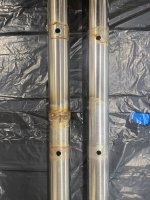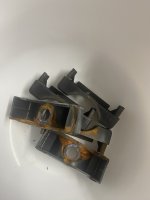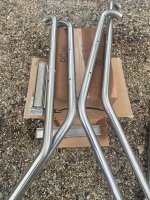- Jun 24, 2021
- 16,869
- Pool Size
- 29000
- Surface
- Vinyl
- Chlorine
- Salt Water Generator
- SWG Type
- CircuPool RJ-60 Plus
this may take a year or two to see if there is a case for this type of corrosion control.
Backstory: Bought house with a pool in 2020. In June 2022, I bought a new ladder, because there was a little bit of rusting, so I bought a 316 SS Marine Grade ladder and installed. I bounced along with TFP care, pool has been great.
Fast forward to 2023 and 2024, and I started getting rusting and pitting on the ladder. In the June of 2024, my heater went out (Raypak Heater leaking. Rebuild thread.).
The rust and the heater led me to evaluate everything. After much contemplation, I concluded two things.
Now that we eliminated CSI from helping, the next advice we provide is “keep your pH >7.” My pH was typically 7.4 during this time, so “couldn’t be pH.” We all know that low pH <7.0 can corrode metals, but is that enough? Maybe not. Luckily there are indexes that provide insight into potential for corrosion to metals. Ryznar (RI) (thanks @JoyfulNoise) and others. An RI of 6-7 is little corrosion, 7-7.5 is significant corrosion, 7-9 there is heavy corrosion.
When I run my RI numbers for 2022/3, with pH of 7.4, TDS of 3045, CA2+ of 50, and HCO3- of 60, and a water temp of 84 Degrees F, my RI was 9.4. Yikes.
What is going on with my chemistry, how’d I get there and what can I do differently?
Looking at the index, we have pH, TDS (mostly salt in my pool), Calcium ions, and bicarbonate (TA). pH has a big influence on the index, TDS, Calcium and bicarbonate has some influence on the index. I decided to use Borates when I installed the salt cell to lower pH in the cell and keep the plates clean (works great). However, Borates lowers pH when added; I had a pH of 7.6 when I added borates, which lowered my pH to 7.4. I ran a TA of 60. I also use a cover. With a TA of 60 and a solar cover, pH just sat at 7.4. Never had a thought about raising pH…why would I?, when pH was stable. Calcium is also not necessary in a vinyl pool right? I just never worried about it. Now I do, and my pH and TA.
So with new heater, I changed my approach...
We had a thread this spring that brought me back to the ladders...what am I going to do?, they are fugly. ( Rust on hand rail at water line ). I did my investigation and put together a plan, and wrote up wiki content. (Corrosion - Further Reading) and (Salt - Further Reading)
Sooooo, my next plan of attack is prevention, namely putting a barrier on the stainless. I pulled out the old ladders, which were not as bad as I remembered (old right, new left):

The plan:
Read the wiki on the causes and protection, but the plan is to remove the rust, passivating (removing surface contaminants like iron particles and restoring the protective chromium oxide later on stainless steel), then sealing the metal. I'm going to use naval jelly for removal, Teknikem CitriSurf 77 Plus for passivating, Everbrite for a sealer. The sealer will protect the SS from the water. There may be some issues at mating surfaces that scratch the Everbrite, but it is worth a shot. Also not in the wiki, but entirely possible is that the "splash zone effect" in the wiki is the cause for the waterline rust, the below the waterline rust may be that the bolts are a different metal than the stairs and tube causing galvanic corrosion on steps below the waterline. I have not been able to source 316 marine grade bolts...the ones that were used are advertised as such by SR. Smith.
NOTE: Everbrite recommends a 2 week cure period before submerging in water. Plan ahead.

First Phase, rust removal Before (notice the step above the waterline with no corrosion:


After:



Next up? Passivating and sealing...for another day!
Give me your best shot @JoyfulNoise I got nothing better...



(side note, if you want to run your own numbers, use your pH, consult the “Draining” wiki to calculate your TDS, for calcium ions take your CH and multiply by .4, and for bicarbonate, just use your TA, and the RI calculator here: ryznar stability index )
Backstory: Bought house with a pool in 2020. In June 2022, I bought a new ladder, because there was a little bit of rusting, so I bought a 316 SS Marine Grade ladder and installed. I bounced along with TFP care, pool has been great.
Fast forward to 2023 and 2024, and I started getting rusting and pitting on the ladder. In the June of 2024, my heater went out (Raypak Heater leaking. Rebuild thread.).
The rust and the heater led me to evaluate everything. After much contemplation, I concluded two things.
- Running my VSP slow did not provide enough flow to properly run the heater, leading to overheating. To protect the new heater, I installed a flow meter to ensure I had enough flow for the new heater to protect it . I also added a flow switch in series with the pressure switch on the heater, so insufficient flow will shut down heater (pound of prevention and all.... (see my post above for details).
- Something was up chemically, as @1poolman1 described in his assessment of the heater, and my post inspection, is that the heat exchanger had corroded.
Now that we eliminated CSI from helping, the next advice we provide is “keep your pH >7.” My pH was typically 7.4 during this time, so “couldn’t be pH.” We all know that low pH <7.0 can corrode metals, but is that enough? Maybe not. Luckily there are indexes that provide insight into potential for corrosion to metals. Ryznar (RI) (thanks @JoyfulNoise) and others. An RI of 6-7 is little corrosion, 7-7.5 is significant corrosion, 7-9 there is heavy corrosion.
When I run my RI numbers for 2022/3, with pH of 7.4, TDS of 3045, CA2+ of 50, and HCO3- of 60, and a water temp of 84 Degrees F, my RI was 9.4. Yikes.
What is going on with my chemistry, how’d I get there and what can I do differently?
Looking at the index, we have pH, TDS (mostly salt in my pool), Calcium ions, and bicarbonate (TA). pH has a big influence on the index, TDS, Calcium and bicarbonate has some influence on the index. I decided to use Borates when I installed the salt cell to lower pH in the cell and keep the plates clean (works great). However, Borates lowers pH when added; I had a pH of 7.6 when I added borates, which lowered my pH to 7.4. I ran a TA of 60. I also use a cover. With a TA of 60 and a solar cover, pH just sat at 7.4. Never had a thought about raising pH…why would I?, when pH was stable. Calcium is also not necessary in a vinyl pool right? I just never worried about it. Now I do, and my pH and TA.
So with new heater, I changed my approach...
- I run my TA at 80 (which also matches my fill water luckily), so I just don’t worry about TA anymore. This helped my RI a bit.
- I run my pH at 7.8, with is just fine with a TA of 80. With the cover, I add acid twice a year, maybe.
- I run my Calcium at 300 to start the year, with all our rain, and backwash, I end up about 200-250 by the end of the year. Having the calcium also helps protect the copper in the gas heater. ( Calcium Hardness - Further Reading )
We had a thread this spring that brought me back to the ladders...what am I going to do?, they are fugly. ( Rust on hand rail at water line ). I did my investigation and put together a plan, and wrote up wiki content. (Corrosion - Further Reading) and (Salt - Further Reading)
Sooooo, my next plan of attack is prevention, namely putting a barrier on the stainless. I pulled out the old ladders, which were not as bad as I remembered (old right, new left):

The plan:
Read the wiki on the causes and protection, but the plan is to remove the rust, passivating (removing surface contaminants like iron particles and restoring the protective chromium oxide later on stainless steel), then sealing the metal. I'm going to use naval jelly for removal, Teknikem CitriSurf 77 Plus for passivating, Everbrite for a sealer. The sealer will protect the SS from the water. There may be some issues at mating surfaces that scratch the Everbrite, but it is worth a shot. Also not in the wiki, but entirely possible is that the "splash zone effect" in the wiki is the cause for the waterline rust, the below the waterline rust may be that the bolts are a different metal than the stairs and tube causing galvanic corrosion on steps below the waterline. I have not been able to source 316 marine grade bolts...the ones that were used are advertised as such by SR. Smith.
NOTE: Everbrite recommends a 2 week cure period before submerging in water. Plan ahead.

First Phase, rust removal Before (notice the step above the waterline with no corrosion:


After:



Next up? Passivating and sealing...for another day!
Give me your best shot @JoyfulNoise I got nothing better...


(side note, if you want to run your own numbers, use your pH, consult the “Draining” wiki to calculate your TDS, for calcium ions take your CH and multiply by .4, and for bicarbonate, just use your TA, and the RI calculator here: ryznar stability index )
Last edited:








